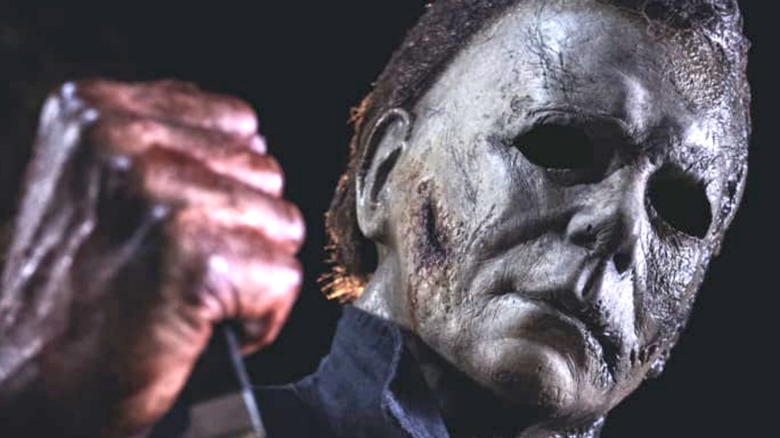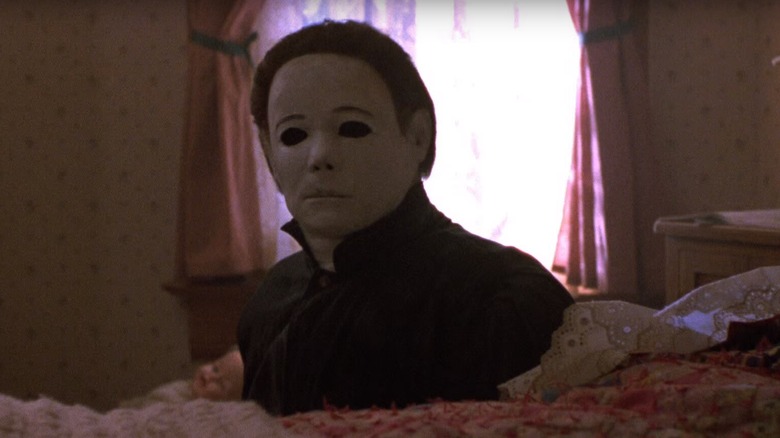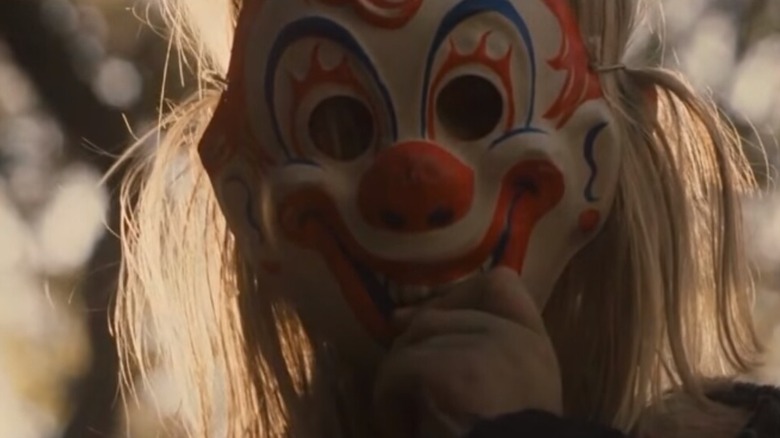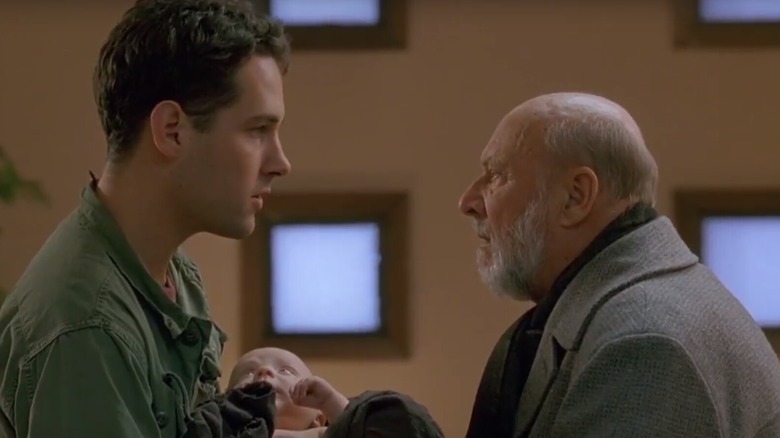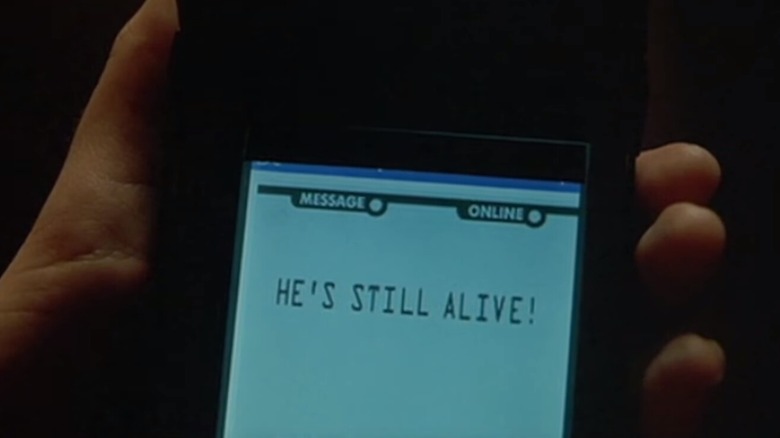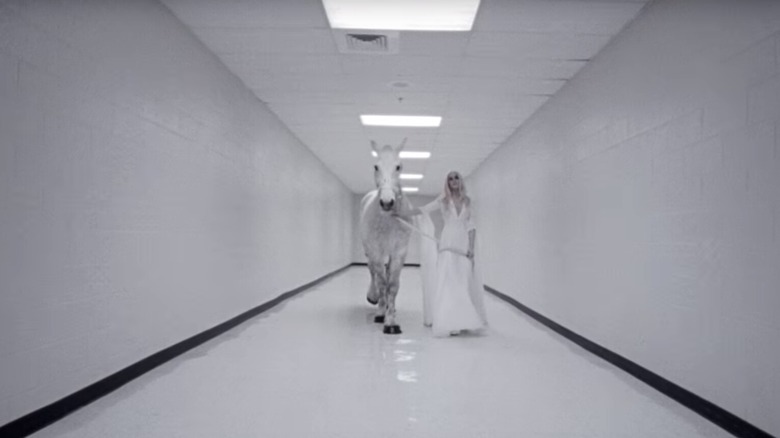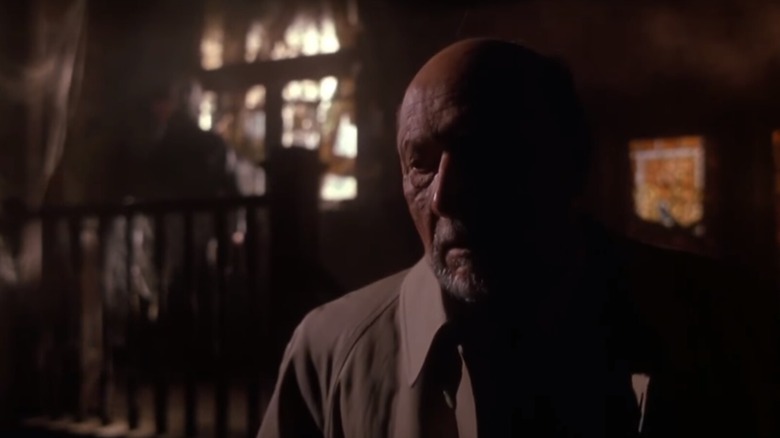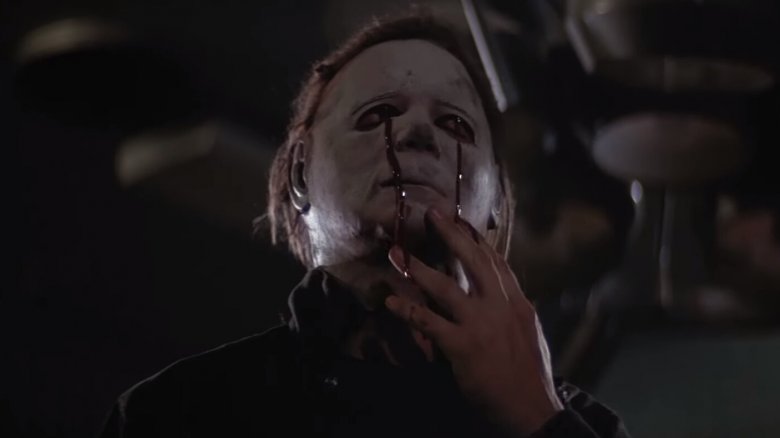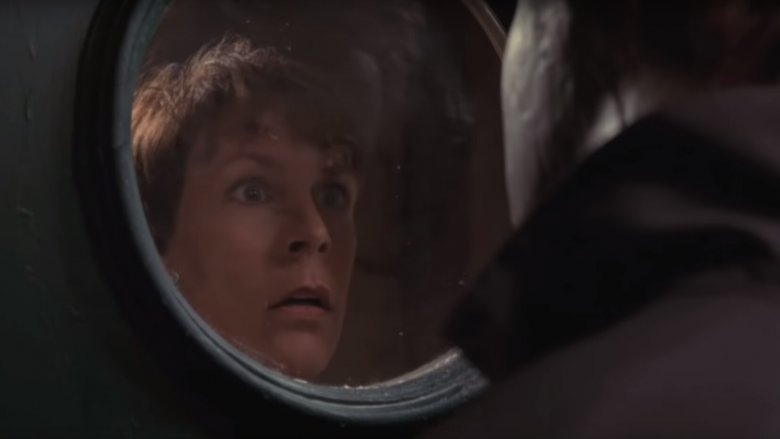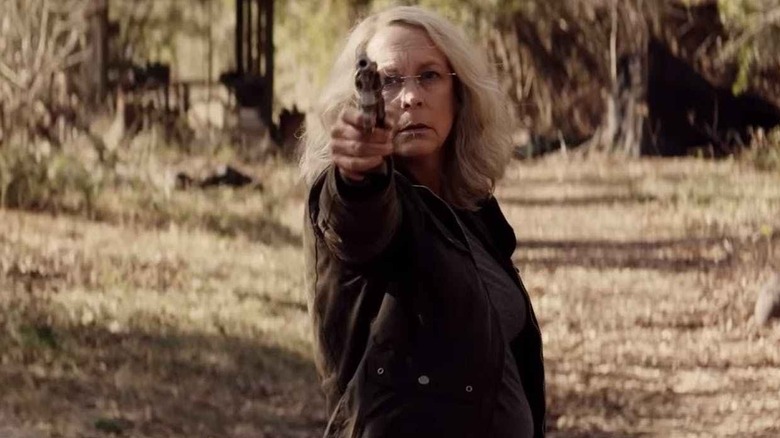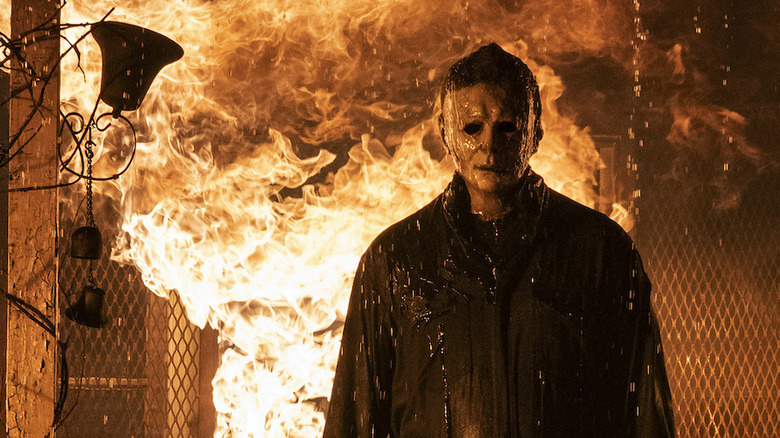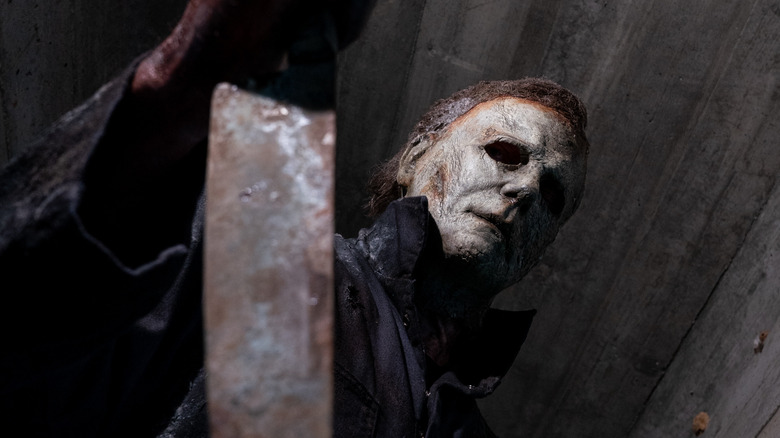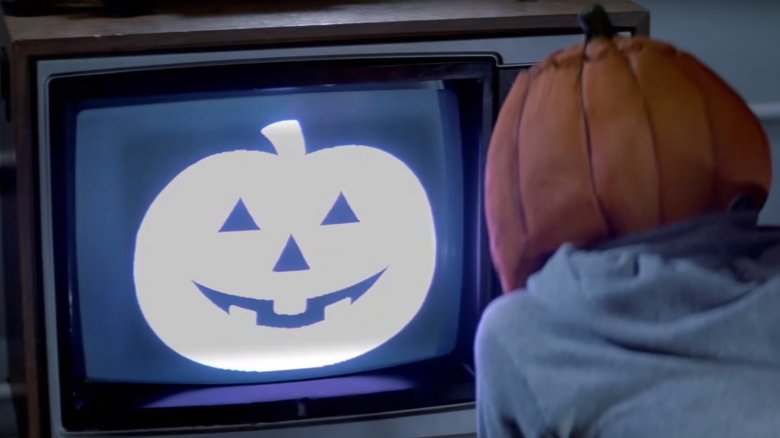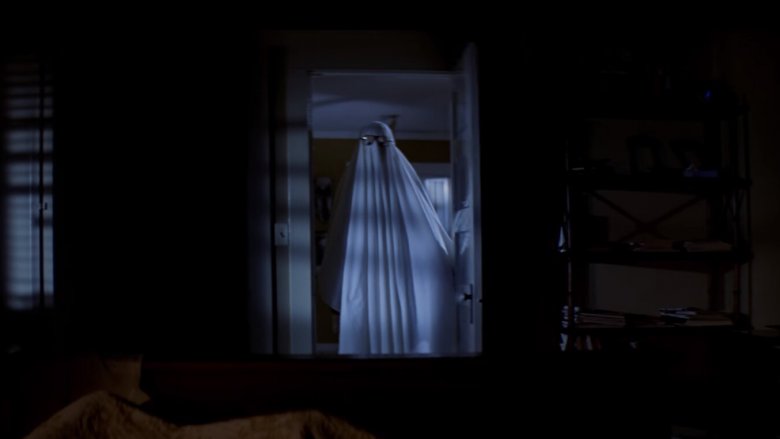Every Halloween Movie Ranked Worst To Best
More than 40 years ago, John Carpenter's "Halloween" brought the horror genre into a new age, defining the modern slasher film. Since then, others have picked up the glistening, blood-soaked knife — most notably Rob Zombie (with 2007's "Halloween" and 2009's "Halloween II") and Blumhouse with director David Gordon Green and writer Danny McBride (for 2018's "Halloween" the highest-grossing film in the history of the franchise). Now, decades later, there has never been a better reason to look upon that creepy William Shatner mask and exclaim: "Death has indeed come to our little town, Sheriff."
Since 1978, there have been a total of 12 films in the "Halloween" franchise, including sequels, remakes, and a darn-good detour that didn't even include Michael. This does not include the time "Wayne's World" star Mike Myers made fun of his namesake, nor does it include "Halloween Ends," the supposed final film in the Green/McBride/Blumhouse trilogy that will be slicing and dicing its way onto screens in the future.
With "Halloween Kills" here to once again reunite us with legendary Scream Queen Jamie Lee Curtis as Laurie Strode, and autumn leaves once again crackling underfoot, now seems like the perfect time to hide behind some bushes, do some heavy breathing, and stroll methodically through "Halloween" history like Michael stalking an unsuspecting teenager. Below is a franchise ranking, from worst to best.
13. Halloween 4: The Return of Michael Myers (1988)
In terms of entertainment value, the greatest sin a movie can commit — particularly a horror movie — is to be boring. While other "Halloween" sequels have failed more spectacularly than this 1988 film that brought Michael back to the franchise, at least those deserve extra points for ambition. "The Return of Michael Myers" coasts on its own concept because it does exactly what the title promises, responding to audience demand after the Myers-less "Season of the Witch."
"Return" picks up ten years after the original film, finding Michael (George P. Wilbur) as he wakes from a decade-long coma and overhears that he has a niece. From that stunningly unbelievable beginning, it doesn't get much more thrilling. Laurie Strode has died in a car accident (the first of two insultingly unceremonious deaths that Jamie Lee Curtis has been subjected to in the series), leaving a young daughter, Jamie (Danielle Harris). Michael meanders mechanically into town to find her, with his old nemesis Dr. Sam Loomis (a rapidly-aging, but still game Donald Pleasence) in tow.
With the mystery of the original "Halloween" long since gone, "The Return of Michael Myers" turns into a tepid retread of Carpenter's film. Michael begins mowing down the teenage friends of little Jamie's foster sister like a super-powered robot, flat cinematography giving the uninspired action no shadows to hide in. This is frequently a very visible shape.
Compounding the frustration with the mediocrity of "Halloween 4" is the fact that John Carpenter had an intriguing pitch for a Myers return that he had co-written with Dennis Etchison, as Etchison would later recall in a 2017 interview with Blumhouse.
"[In the proposed script there was] a town meeting where everyone is arguing, and the guy who runs the drive-in says, 'You can't ban a night of Halloween movies! I'm trying to make a living here! Kids wanna see horror movies!"" Etchison explained. "'Well, maybe they shouldn't,' some people are saying. 'Maybe it's better if they don't see them." So the whole idea was repression versus acknowledging the bad things in the world."
Ultimately, series producer Moustapha Akkad's rejection of the concept as "too cerebral" would push Carpenter and legendary producer Debra Hill to sell their controlling interest in the series — Carpenter's involvement remaining absent from here on out, until he signed on to produce the Blumhouse reboot trilogy and, like Michael himself, come home.
12. Halloween (2007)
If "Halloween 4" disappoints by being too safe, this one went too far in the opposite direction. It was a bold choice by Dimension Films to hire a filmmaker with as unique a vision as Rob Zombie to set a new direction for the series. Unfortunately, the result is an overcomplicated, unpleasant mess of an experience stuck halfway between reboot and prequel.
You know how Ron Howard's "How the Grinch Stole Christmas" is two-thirds unnecessary backstory and one-third remake of something that was already perfect? Rob Zombie's "Halloween" is Ron Howard's "Grinch," but all the Whos are oversexed rednecks. (Well, more so.) The film dwells on the abusive childhood that warped young Michael Myers' (Daeg Faerch) mind before leaping forward in time to recreate John Carpenter's chaotic 31st of October.
Mr. Zombie is an auteur with no small amount of style, and he assembles a solid cast (Malcolm McDowell, Scout Taylor-Compton, and Brad Dourif are all quite good as Dr. Loomis, Laurie Strode, and Sheriff Brackett, respectively). Unfortunately, the relentless dreariness and unstable structure make it nearly impossible to connect with any of the characters. There are enjoyable "Halloween" movies, and there are enjoyable Rob Zombie movies, but this one deserves to be forgotten faster than you can slam in the back of your Dragula.
11. Halloween: The Curse of Michael Myers (1995)
This movie got off on the wrong foot as soon as it dropped its far more metal working title of "Halloween 666." That was only the beginning of production troubles that left "The Curse of Michael Myers" so compromised that fans would go on to circulate an early workprint version, labeled a "Producer's Cut," as a bootleg for nearly 20 years before it was officially released. In fact, writer Daniel Farrands revealed in a Fangoria interview that the "Curse" of the title started as a joke about the nightmarish process of making the film.
This 1995 entry finds Jamie (now played by J. C. Brandy) escaping from a cult six years after she and her unkillable Uncle Michael (George P. Wilbur returning) were abducted by a mysterious Man in Black at the end of "Halloween 5." She gives birth just before Michael murders her with a corn thresher, but her baby lives and winds up in the care of Tommy Doyle (Paul Rudd, mere months after making his film debut in "Clueless"). Tommy has been obsessed with Myers ever since surviving the events of the original film, and he teams up with Dr. Loomis (Donald Pleasence again, in his final performance) to protect the newborn.
The plot that unfolds reveals the secrets of the Cult of Thorn, a Druidic order bent on cultivating power through familial sacrifices. Their leader is the Man in Black, who is revealed to be Dr. Terence Wynn (Mitchell Ryan), a character who appeared in one scene of the original "Halloween" that you almost certainly won't remember. This tangled drama leaves little room for either scares or fun, meaning the most compelling reason to watch is to marvel at how little Paul Rudd has aged in over a quarter century.
10. Halloween: Resurrection (2002)
Some slasher series, like "Friday the 13th," find strength in getting increasingly ridiculous with each sequel, promising that, if things won't be scary anymore, they'll at least be fun. "Halloween," on the other hand, has a track record of taking interesting sequel concepts and wasting them on overly-serious execution. There may be no better example of this problem than 2002's "Halloween: Resurrection."
This eighth entry in the franchise begins as a satire of the then-booming reality TV phenomenon, with a webcast show called "Dangertainment" locking contestants into the old Myers house for a night of scares. The hosts (Tyra Banks and Busta Rhymes) have prepared a number of spooky traps for the players, but the danger(tainment) gets real when Michael (Brad Loree) comes home. The first murder victim, sadly, is the cleverness of this setup — as the movie devolves into a fairly unmemorable romp through dark rooms.
Watching Busta Rhymes yell at a computer is fun (no sarcasm, that is the best part of the movie), but even he can't save "Resurrection" from becoming a dreary slog. It doesn't help that the film has to open with a convoluted retcon to undo the ending of "Halloween H2O," which had been intended as a series finale. As part of this, Jamie Lee Curtis appears in a sad cameo as Laurie Strode, unceremoniously murdered in a mental hospital before the main titles even roll.
9. Halloween II (2009)
Mr. Zombie returned to write and direct a second Michael Myers murder adventure, and it was a marked improvement over his first attempt. No longer bound by the obligation to remake John Carpenter's original, Zombie's sequel cut loose for a unique story examining the effects of the previous film's traumas on its characters. Loomis was trying to sell his new book, Laurie was plagued by intrusive murderous impulses, and Michael was driven home by visions of his mother (Sheri Moon Zombie).
Zombie chose to shoot "Halloween II" on 16mm film, lending it an authentically gritty grindhouse feel that set it apart from most glossy modern horror movies. This decision played to the movie's strengths, namely its strikingly surreal, hallucinatory images. While more psychologically interesting than many other entries in the series, its big ideas are still sadly buried under uninspired violence and an unrelentingly grim tone. After this films, the next direction for the franchise became quite foggy, as Dimension Films' failure to launch the next "Halloween" resulted in their loss of the rights after 20 years.
8. Halloween 5: The Revenge of Michael Myers (1989)
What the fifth Halloween may lack in originality, it makes up for with the fun so often lacking in its siblings.
This time, Jamie Lloyd (Danielle Harris again) has been left mute and disturbed by the horror she faced one year earlier. She's experiencing hallucinations that suggest some kind of telepathic link with her uncle Michael (Don Shanks), who vanished down a mine shaft at the end of "Halloween 4." The real joy of "Revenge" is in Donald Pleasence's fourth turn as Dr. Loomis, who gets more and more over-the-top in his desperation to convince authorities that Myers is alive, "pure evil" and coming back once more.
The appeal of this film's teen cast is unmatched by any other "Halloween" film besides the original, decked out in late '80s fashions and talking about how love makes your heart "feel like it's made of neon." Jamie's climactic flight up a laundry chute to escape her uncle's knife has more genuine tension than the other sequels' murders combined. It also gave audiences one of the most bonkers moments in the series, in which Loomis traps Michael in a net and beats him with a two-by-four, screaming "Die, die!"
7. Halloween II (1981)
"Michael Myers was an absence of character," John Carpenter said in a 2014 Deadline interview, "and yet all the sequels are trying to explain that. That's silliness." Carpenter turned down the opportunity to direct "Halloween II," but agreed to write it (along with Debra Hill) in the interest of maintaining some share in the phenomenon he had helped create. The result is a film that continues the story of "Halloween" as directly as possible, while being desperate to feel different.
Carpenter, Hill, and director Rick Rosenthal knew that the mystique of Michael could never be recaptured in the same way as the 1978 original. To that end, "Halloween II" ratchets up the gore factor, in the style of then-new slashers like "Friday the 13th." Picking up in the final scene of its predecessor, the sequel is set entirely on the very same night, letting Myers (Dick Warlock) loose in a hospital in search of Laurie (Curtis) with Dr. Loomis (Pleasence) in pursuit. Among the memorable murders in this more body count-oriented outing are a hammer to the head, a hot tub drowning, and a syringe in the eye.
Meanwhile, Michael's motivations are explored, revealing for the first time the family connection that would go on to define the rest of the sequels. In the end, "Halloween II" is a movie that believes it shouldn't exist but nevertheless gives a valiant effort attempting to provide a good time. "I had to write the second movie," Carpenter admitted candidly in the Deadline interview, "and every night I sat there and wrote with a six pack of beer trying to get through this thing. And I didn't do a very good job, but that was it. I couldn't do any more."
6. Halloween H20 (1998)
"Halloween H20" is undoubtedly one of the silliest titles in horror history. The movie isn't even about water! Maybe Michael didn't want to intrude on Jason's turf ... or surf. At any rate, the title refers to the 20 years that have passed since the first two "Halloween movies." Laurie Strode (Curtis) has been living under an assumed name after faking her death, serving as headmistress of a private school attended by her teenage son John (Josh Hartnett).
"H20" is very much a "Halloween" for the "Scream" generation ("Scream" writer Kevin Williamson even served as producer). The late '90s vibes are strong, from Hartnett to LL Cool J (as a school security guard) to the Creed jam that plays over the closing credits. John Carpenter declined again to return, but director Steve Miner delivers a tight, slick thriller that lets Laurie fight back when Michael (Chris Durand) comes for her son.
It's Jamie Lee Curtis who makes H20 worth watching. Not only is her performance as a still-haunted, middle-aged Laurie compelling, but the story was her idea. "That was how I pitched the movie: regaining the soul by facing your own fear," she recalled in a Los Angeles Times interview. "When the stalkee becomes the stalker, I guarantee you the audience will go crazy."
5. Halloween (2018)
After years of disproved rumors and inactivity seemed like they might finally be the stake through the heart of Michael Myers, he once again rose from the dead. In 2017, it was announced that Blumhouse Productions had hired David Gordon Green and Danny McBride to reinvigorate the franchise for a new generation — while simultaneously reflecting on an old one.
The result was Jamie Lee Curtis' iconic Laurie Strode reinvented for a new generation as a survivor-turned-survivalist. This time, when Michael came back to Haddonfield, the final girl would be ready — aided by her daughter and granddaughter.
Audiences responded well to the end result, which ignored all the sequels while looking back on the horrors of 1978 and the lifelong repercussions still influencing characters like Laurie. Green's directorial talents proved a perfect fit, as did the clever script — clearly, there was a lot of talent behind the camera this time around, and name actors (Curtis, Judy Greer, Will Patton) in front of it, and this "Halloween" was a long way from its mid-'90s borderline-straight-to-video low points.
The result was the highest-grossing "Halloween" film ever made, an undeniable mandate for Green and McBride and crew to keep going down this path — and sure enough, two sequels had been planned. Like Michael when he sees a babysitter, they were clearly onto something.
4. Halloween Kills (2021)
2018's "Halloween" lit the fire, but it was 2021's "Halloween Kills" that proved to be straight fire.
The script, which cleverly jumps back and forth between 1978 and 2018 Haddonfield, might pay more lip service to the fanbase than any other sequel in the franchise. You see Donald Pleasence as Dr. Loomis (through some sort of digital trickery), you get tons of backstory on Officer Hawkins, the majority of the action is driven by a vengeful Tommy Doyle — and oh yeah, Laurie Strode (once again played by Jamie Lee Curtis) is in it, too. There's even a charming subplot involving several "survivors" of Michael's attacks over the years — even if, well, let's just say the next meeting of that group is going to be really small.
There's humor (two colorful characters have given an extreme makeover to the Myers murder house), there's some truly original kills (many involving the firemen who show up to deal with the finale of the last film), and David Gordon Green once again is as effective with his artistry as he is with the gore. Sure, a subplot involving a second escaped convict is a boring red herring, but other than that it is hard to find a misstep.
If you love the "Halloween" films (and if you're not, you've made a strange article selection for your reading), you'll love how "Halloween Kills" gives so much fan-service, while simultaneously playing as a continuation for anyone who has only seen the previous Green film, and a bridge to whatever is planned for "Halloween Ends."
Much like the original two "Halloween" films, these new movies both take place right after the other, the sequel is predominantly set in a hospital — and taken together, they feel like one long, masterful exercise in horror.
3. Halloween Ends (2022)
"Halloween Ends" is the 13th "Halloween" movie overall, and the third and final entry in David Gordon Green's surprisingly elegant, thoughtful, character-driven reboot trilogy that examines the traumatizing, addictive effects of violence as much as it is a series of jump scares, gore, and chaos. It's a delicate balance, but Green pulls it off, thanks in large part to the masterful horror-acting work of Jamie Lee Curtis, an old-school scream queen who starred as Laurie Strode in the original "Halloween" back in the late '70s.
Things have died down in the cursed town of Haddonfield four years after Michael Myers' latest murder binge, but he's just lying in wait, living in a sewer pipe, until a vulnerable victim hypnotically transforms into a fellow killing machine. After accidentally killing a kid while babysitting, Corey Cunningham (Rohan Campbell) becomes the town pariah, and while developing a relationship with Laurie's granddaughter Allyson (Andi Matichak), endures routine beatings, and is thrown off an overpass where he encounters Myers.
From there, and under the influence of the Shape, Corey launches a stabby spree against the town that has spurred him. This leads to one of the bloodiest, longest, and most difficult to watch scenes of violence, gore, and brutality in recent horror movie memory as Laurie and Michael square off, putting an "End" to it all.
"Halloween Ends" split fans and critics alike, some of whom appreciated that it was trying something new while others felt cheated by Michael's minimal screentime and an over-reliance on Campbell as the film's main villain. Appropriately then, the film is hovering at about the halfway mark on Rotten Tomatoes, between both critics and viewers alike.
"It's not a bad way to go out," ReelViews said in its review. "At least it has the virtue of trying something new." Calling it a "muffled bang," The Huntsville Item added: "It might not be the 'Halloween' film you expected, but that's exactly the point."
2. Halloween III: Season of the Witch (1982)
The boldest thing attempted by any of the Halloween sequels is to not be a "Halloween" sequel. Still convinced that more Michael Myers would be a case of diminishing returns, Carpenter and Hill decided to transform the franchise into an anthology series, with the third film telling a new story about Halloween night. They enlisted Tommy Lee Wallace (art director of the original Halloween) to write and direct "Season of the Witch."
The movie is actually about an ancient order of warlocks, but "Season of the Warlock" doesn't have the same ring to it. The head of a novelty company, Conal Cochran (Dan O'Herlihy), is plotting to slaughter the masses of American children wearing his absurdly popular masks on Halloween night. The masks, powered by microchips containing pieces of Stonehenge and triggered by a TV commercial, cause bugs and snakes to explode from the heads of their wearers. With this plague, Cochran intends to get revenge for the commercialization of Halloween and usher in a new age of witchcraft.
The problem with "Halloween III" is that it isn't quite as bonkers as that plot summary might sound. We watch the mystery unfold from the point of view of Dr. Daniel Challis (Tom Atkins), a womanizing drunk who's fairly unlikeable. The fun does kick off once we get to the mask factory, but the tone up to that point is too serious to fully buy the wild plot points that pull everything together. Still, its weirdness is refreshing amidst the formulaic slashers that make up the sea of "Halloween" sequels and imitators.
"Season of the Witch" is full of clever and memorable moments, like the unforgettable "Silver Shamrock" jingle (seriously, good luck forgetting it) and a TV screening of the original "Halloween" playing an important part in the story. Unfortunately, it was subjected to disappointing box office and scathing reviews from fans and critics spurned by the new direction, and the intriguing anthology concept was abandoned.
1. Halloween (1978)
Any list arranging the "Halloween" films from worst to best is doomed to be anticlimactic, because there's only one way for it to end. The merits of every sequel and reboot can be debated, but there's no denying that the original is in a class of its own. No hot takes here: the best "Halloween" movie is 1978's "Halloween."
When producers Moustapha Akkad and Irwin Yablans hired John Carpenter and Debra Hill to make a low-budget horror movie, they set out to do nothing more than to make the best little scarefest they could. "Halloween" became legendary because it's elemental. Its teen characters, led by Jamie Lee Curtis with snappy dialogue written by Hill and Carpenter, are charmingly ordinary. Donald Pleasence plays Dr. Sam Loomis as just paranoid enough that authorities don't listen to him. There are no contrived plot twists or convoluted motivations behind Michael Myers (Nick Castle). He's just a man in a mask who's waiting to kill you.
That waiting is the key to the power of "Halloween." There are surprisingly few murders in the film, and the killings that do occur are almost entirely bloodless. Carpenter doles out just enough omens of the Shape's presence to instill the audience with dread. The tension hovering over the likable cast steadily builds until the spree begins, kicking off a rollercoaster to the climax. Add in the shadows of Dean Cundey's cinematography and Carpenter's creepy keyboard score, and you've got a minimalist masterpiece that redefined a genre by reminding audiences that all you need is "one good scare."
